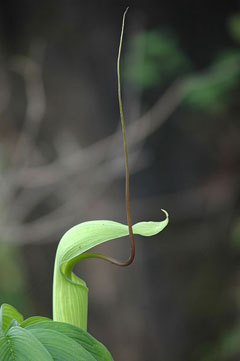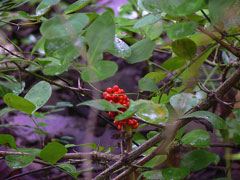 |
|
|
 |
| http://flickr.com/photos/dinesh_valke/1081191507 |
Translate this page:
Summary
Physical Characteristics

 Arisaema tortuosum is a PERENNIAL growing to 0.6 m (2ft) by 0.3 m (1ft in).
Arisaema tortuosum is a PERENNIAL growing to 0.6 m (2ft) by 0.3 m (1ft in).
See above for USDA hardiness. It is hardy to UK zone 7. It is in flower from May to June. The species is monoecious (individual flowers are either male or female, but both sexes can be found on the same plant) and is pollinated by Flies. The plant is not self-fertile.
Suitable for: light (sandy) and medium (loamy) soils and prefers well-drained soil. Suitable pH: mildly acid, neutral and basic (mildly alkaline) soils. It can grow in full shade (deep woodland) semi-shade (light woodland) or no shade. It prefers moist soil.
UK Hardiness Map
US Hardiness Map
Synonyms
A. curvatum. (Roxb.)Kunth. Arum tortuosum.
Plant Habitats
Woodland Garden Dappled Shade; Shady Edge; not Deep Shade;
Edible Uses
Edible Parts: Root
Edible Uses:
Tuber - it must be thoroughly dried or cooked before being eaten[51, 177]. The tubers are boiled and eaten in Nepal, mixed with lime juice (Citrus aurantifolia) or another sour substance[272]. The tubers are buried in masses in pits until acetous fermentation takes place, they are then dug up, washed and cooked, by which means their acrimonious principles are in part dispersed[2]. However, violent illness has still been known to follow a hearty meal of the tubers[2]. See also the notes above on toxicity.
References More on Edible Uses
Medicinal Uses
Plants For A Future can not take any responsibility for any adverse effects from the use of plants. Always seek advice from a professional before using a plant medicinally.
Vermifuge
The roots have been used as a vermifuge in cattle[240, 243]. The juice of the tubers is applied to the wounds of cattle in order to kill any parasites[272]. The dried powdered tubers is applied to snake bites[272]. The seeds have been mixed with salt and used to treat colic in sheep[240, 243, 272].
References More on Medicinal Uses
The Bookshop: Edible Plant Books
Our Latest books on Perennial Plants For Food Forests and Permaculture Gardens in paperback or digital formats.

Edible Tropical Plants
Food Forest Plants for Hotter Conditions: 250+ Plants For Tropical Food Forests & Permaculture Gardens.
More

Edible Temperate Plants
Plants for Your Food Forest: 500 Plants for Temperate Food Forests & Permaculture Gardens.
More

More Books
PFAF have eight books available in paperback and digital formats. Browse the shop for more information.
Shop Now
Other Uses
Insecticide
The tubers have insecicidal properties[272].
Special Uses
References More on Other Uses
Cultivation details
Prefers a cool peaty soil in the bog garden, woodland garden or a sheltered border in semi-shade[134, 200]. Prefers a loamy or peaty soil and will tolerate a sunny position if the soil is moist but not water-logged and the position is not too hot or exposed[1, 200]. Plants are not very hardy outdoors in Britain and are normally best if given protection[1]. However, they can succeed outdoors in the milder areas of the country if the tubers are planted about 20cm deep[200]. Plants require protection from slugs[200]. Most species in this genus are dioecious, but they are sometimes monoecious and can also change sex from year to year. This species usually bears either monoecious or all male flowers[266].
References Carbon Farming Information and Carbon Sequestration Information
Temperature Converter
Type a value in the Celsius field to convert the value to Fahrenheit:
Fahrenheit:
The PFAF Bookshop
Plants For A Future have a number of books available in paperback and digital form. Book titles include Edible Plants, Edible Perennials, Edible Trees,Edible Shrubs, Woodland Gardening, and Temperate Food Forest Plants. Our new book is Food Forest Plants For Hotter Conditions (Tropical and Sub-Tropical).
Shop Now
Plant Propagation
Seed - best sown as soon as it is ripe in a shady position in a cold frame[134]. Stored seed remains viable for at least a year and can be sown in spring in the greenhouse but it will probably require a period of cold stratification. Germination usually takes place in 1 - 6 months at 15°c[134]. When large enough to handle, prick the seedlings out into individual pots and grow them on in light shade in the greenhouse for at least a coupe of years until the corms are more than 20mm in diameter. Plant out into their permanent positions whilst they are dormant. Division of tubers when the plant dies down in late summer.
Other Names
If available other names are mentioned here
Native Range
TEMPERATE ASIA: China (Sichuan Sheng (southwest), Yunnan Sheng (northwest), Xizang Zizhiqu (south)) TROPICAL ASIA: Bhutan, India, Sri Lanka, Nepal, Pakistan (Himalayan region), Myanmar (north)
Weed Potential
Right plant wrong place. We are currently updating this section.
Please note that a plant may be invasive in one area but may not in your area so it's worth checking.
Conservation Status
IUCN Red List of Threatened Plants Status :

Growth: S = slow M = medium F = fast. Soil: L = light (sandy) M = medium H = heavy (clay). pH: A = acid N = neutral B = basic (alkaline). Shade: F = full shade S = semi-shade N = no shade. Moisture: D = dry M = Moist We = wet Wa = water.
Now available:
Food Forest Plants for Mediterranean Conditions
350+ Perennial Plants For Mediterranean and Drier Food Forests and Permaculture Gardens.
[Paperback and eBook]
This is the third in Plants For A Future's series of plant guides for food forests tailored to
specific climate zones. Following volumes on temperate and tropical ecosystems, this book focuses
on species suited to Mediterranean conditions—regions with hot, dry summers and cool, wet winters,
often facing the added challenge of climate change.
Read More
Expert comment
Author
(Wall.)Schott.
Botanical References
51200266
Links / References
For a list of references used on this page please go here
Readers comment
| Add a comment |
|
If you have important information about this plant that may help other users please add a comment or link below. Only comments or links that are felt to be directly relevant to a plant will be included. If you think a comment/link or information contained on this page is inaccurate or misleading we would welcome your feedback at [email protected]. If you have questions about a plant please use the Forum on this website as we do not have the resources to answer questions ourselves.
* Please note: the comments by website users are not necessarily those held by PFAF and may give misleading or inaccurate information.
To leave a comment please Register or login here All comments need to be approved so will not appear immediately.
|
Subject : Arisaema tortuosum
|
|
|
|